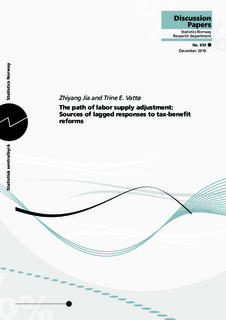| dc.contributor.author | Jia, Zhiyang | |
| dc.contributor.author | Vattø, Trine Engh | |
| dc.date.accessioned | 2018-01-16T13:52:05Z | |
| dc.date.available | 2018-01-16T13:52:05Z | |
| dc.date.issued | 2016-12-05 | |
| dc.identifier.issn | 1892-753X | |
| dc.identifier.uri | http://hdl.handle.net/11250/2477824 | |
| dc.description.abstract | The standard static labor supply model ignores that it takes time for individuals to adjust to a tax-benefit reform.
A labor supply decision model is developed that allows for lagged responses in terms of state dependence, stemming from preferences, labor market constraints and adjustment costs. The parameters of the model are estimated using panel data on working hours for Norwegian females. We find evidence of all three sources of state dependence, with adjustment costs as the most dominant component. When using the model to simulate the path of adjustment to a general tax cut, we find that state dependence brings down responses to only one third of the estimated full effect in the first year. The females reach the proximity of the full effect after about seven years. | nb_NO |
| dc.language.iso | eng | nb_NO |
| dc.publisher | Statistics Norway, Research department | nb_NO |
| dc.relation.ispartofseries | Discussion Papers;No. 854 | |
| dc.subject | Skattereformer | nb_NO |
| dc.subject | Arbeidskraft | nb_NO |
| dc.title | The path of labor supply adjustment: Sources of lagged responses to tax-benefit reforms | nb_NO |
| dc.type | Working paper | nb_NO |
| dc.subject.nsi | VDP::Samfunnsvitenskap: 200::Økonomi: 210::Samfunnsøkonomi: 212 | nb_NO |
| dc.source.pagenumber | 35 s. | nb_NO |
